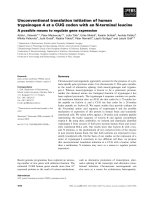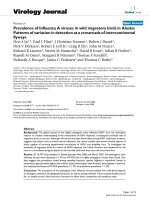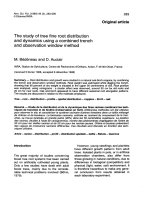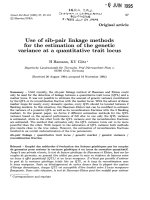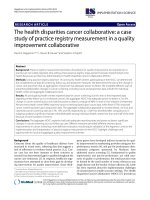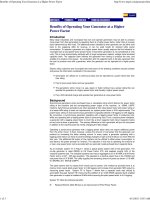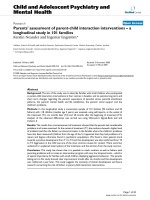Study of wave wind interaction at a seawall using a numerical wave channel
Bạn đang xem bản rút gọn của tài liệu. Xem và tải ngay bản đầy đủ của tài liệu tại đây (1.6 MB, 34 trang )
Accepted Manuscript
Study of Wave – Wind Interaction at a Seawall Using a Numerical Wave Channel
Phung Dang Hieu, Phan Ngoc Vinh, Du Van Toan, Nguyen Thanh Son
PII:
DOI:
Reference:
S0307-904X(14)00208-X
/>APM 9980
To appear in:
Appl. Math. Modelling
Received Date:
Revised Date:
Accepted Date:
28 November 2012
13 January 2014
15 April 2014
Please cite this article as: P.D. Hieu, P.N. Vinh, D. Van Toan, N.T. Son, Study of Wave – Wind Interaction at a
Seawall Using a Numerical Wave Channel, Appl. Math. Modelling (2014), doi: />2014.04.038
This is a PDF file of an unedited manuscript that has been accepted for publication. As a service to our customers
we are providing this early version of the manuscript. The manuscript will undergo copyediting, typesetting, and
review of the resulting proof before it is published in its final form. Please note that during the production process
errors may be discovered which could affect the content, and all legal disclaimers that apply to the journal pertain.
Study of Wave – Wind Interaction at a Seawall Using a
Numerical Wave Channel
Phung Dang Hieu 1* , Phan Ngoc Vinh2, Du Van Toan1, Nguyen Thanh Son3
1
Research Institute for management of Seas and Islands, 125 Trung Kinh Str., Cau Giay, Hanoi,
Vietnam
2
Institute of Mechanics, 264 Doican, Hanoi, Vietnam
3
Faculty of Hydro-Meteorology and Oceanography, Hanoi University of Science, 334 Nguyen Trai
Str., Thanh Xuan, Hanoi, Vietnam
*
Corresponding author: Fax:+84-4-3259-5429
E-mail address: (Phung D. Hieu)
Abstract
This paper presents the study on wind and waves interactions at a seawall using a
numerical wave channel. The numerical experiments were conducted for wave overtopping
of a ¼ sloping seawall using several conditions of incident waves and wind speeds. The
numerical results were verified against laboratory data in a case for wave overtopping
without wind effects. The interaction of waves and wind was analyzed in term of mean wave
quantities, overtopping rate and variation of wind velocity at some selected locations. The
results showed that the overtopping rate was strongly affected by wind and the wind field
was also significantly modified by waves. There exists an effective range of wind speed in
comparison with the local shallow wave speed at the breaking location, which gives
significant effects to the wave overtopping rates. The maximum of wind adjustment
coefficient f w for wave overtopping rate was strongly related to the mean overtopping rate in
the case for no wind. This study also showed that when the mean overtopping rate was
greater than 5 × 10 −4 m3/s/m, the maximum of wind adjustment coefficient f w approached to
a specific value of about 1.25.
Keywords: Wave overtopping; Two-phase model; Overtopping rate; Seawall; Wind effect.
2
1. Introduction
Accurate assessment of wave overtopping at seawall or coastal structures is a key
requirement for effective design of coastal defenses. Wave overtopping has been studied
extensively over the last 30 years (Besley et al. [1], Goda et al. [2], Owen [11], Van de Meer
and Waal [15]). The knowledge on the wave overtopping of seawalls has contributed
significantly to the practical industry and published in some distinct guide books so far.
Among those, it could be mentioned such as “EuroTop Wave Overtopping of Sea Defenses
and Related Structures” [10], TAW (2002) [14] and so on. However, strong waves dangerous
for coastal structures are mostly appeared during the storm weather with the presence of
strong wind. Whereas, formulae for the estimation of wave overtopping have been
empirically formed using experimental data which were measured indoor from experiments
done in wave flumes without presence of wind. Therefore, wave overtopping in practice may
be significantly affected by wind and different from which estimated by using those
empirical formulae.
In the guide book [10], it is pointed out that wind may affect overtopping processes and
thus discharges by: changing the shape of the incident wave crest at the structure resulting in
a possible modification of the dominant regime of wave interaction with the wall; blowing
up-rushing water over the crest of the structure (for onshore wind) resulting in possible
modification of mean overtopping discharge and wave-by-wave overtopping volumes;
modifying the physical form of the overtopping volume or jet, especially in terms of its
aeration and break-up resulting in possible modification to post-overtopping characteristics
such as throw speed, landward distribution of discharge and any resulting post-overtopping
loadings [10]. However, very few experimental studies of wind effect on wave overtopping
have been found so far. Iwagaki et al. [6] studied the wind effect on wave overtopping of
3
vertical seawalls by doing experiments in a small scale wave flume with a wind tunnel. Their
results confirmed that the wind effects on the rate of wave overtopping on vertical seawalls
were very important. However, they commented that their results were of only some cases
for vertical seawalls and not sufficient to apply to practical purposes. Ward et al. [16, 17]
carried out experiments using a physical wave flume with wind facilities to study the effects
of strong onshore winds on run-up and overtopping of coastal structures. Although, it is
widely assumed that onshore winds significantly result in increasing run-up and overtopping,
very few formulae and experimental data estimating the wind effects on run-up and
overtopping have been published [8]. Thus, further studies with more systematic
investigations need to be carried out to disclose the mechanism of wave overtopping.
Numerical simulation of wave overtopping is very difficult due to the complex process
of the wave overtopping itself and in the treatment of the overturning free surface in a
numerical model [5]. For a decade, the numerical model based on the Navier-Stokes
equations together with the volume of fluid (VOF) method has been known as a potential tool
for the simulation of wave breaking and wave overtopping. However, the simulation of wave
overtopping with wind effect is still limited. Recently, Li and He [7] have studied the wind
effects on wave overtopping by using a two-phase solver. Their results showed the capability
of the two-phase model in simulation of wind and wave movement and therefore showed the
wind effects on wave overtopping of a structure.
Hieu et al. [3], Hieu and Tanimoto [4], Hieu and Vinh [5] proposed a numerical VOFbased two-phase flow model for wave breaking, wave-structure interaction and wave
overtopping of seawall supported by porous structures. Their studies on verification of the
model for wave breaking, wave structure interaction and wave overtopping showed that the
model has good capability in making numerical experiments on wave motion and wave
structure interaction including wave breaking and overtopping. In this study, the proposed
4
model [4, 5] is used as the core of a numerical wave channel for carrying out numerical
experiments on wind-wave interaction and studying wind effects on wave overtopping of a
slopping seawall. Firstly, the numerical wave channel is used to carry out an experiment in
the condition similar to the experiment done in a laboratory wave flume in order to verify the
numerical wave channel. Then, a series of numerical experiments are carried out for the
investigation of wind effects on wave overtopping and wave quantities as well as for the
study of wind modification by wave motion.
2. Numerical wave channel and experiment setup
2.1. Numerical wave channel
The numerical model proposed by Hieu and Tanimoto [4] and Hieu and Vinh [5], which
was based on the Navier-Stokes equations extended to porous media (Sakakiyama and
Kajima, [12]) and the Smagorinsky turbulence model [13], was applied as the core of the
numerical wave channel for conducting numerical experiments. The numerical wave channel
used a source wave maker method in order to minimize the reflection of waves at the wave
maker boundary. The source wave maker consists of two parts the source function and the
damping zone. The source function is added to the mass conservation equation in order to
generate the desired incident waves. While the damping zone works as an energy dissipation
one by adding a resistance force proportional to the flow velocity to the momentum equations
(refer to [4], [9] for more detail). Fig. 1 presents a schematic view of the numerical wave
channel.
2.1.1 Governing equations
The governing equations for the numerical wave channel in a 2-dimensional model are
briefly written as follows:
5
Continuity equation:
∂γ xu ∂γ zw
+
= qmγv
∂x
∂z
(1)
Modified Navier-Stokes equations:
λv
λv
γ ∂p ∂
∂u ∂λ x uu ∂λ z wu
∂u ∂
∂u ∂w
+
+
=− v
+ γ xν e 2 + γ zν e +
− D x u − R x + q u
∂t
∂x
∂z
ρ ∂x ∂x
∂x ∂z
∂z ∂x
(2)
∂w ∂λxuw ∂λz ww
γ ∂p ∂
∂w ∂u ∂
+
+
=− v
+ γ xν e
+ +
ρ ∂z ∂x
∂t
∂x
∂z
∂x ∂z ∂z
(3)
∂w
− Dz w − Rz − γ v g + qw
γ zν e 2
∂z
Advection equation for the volume of fluid fractional function:
∂γ v F ∂uγ x F ∂wγ z F
+
+
= qF
∂t
∂x
∂z
(4)
Equation for the estimation of density and viscosity for the two-phase flow model:
ρ = (1 − F ) ρ a + Fρ w
(5)
ν = (1 − F )ν a + Fν w
(6)
where t: time, x and z are the horizontal and vertical coordinates, u, w: horizontal and vertical
velocity component respectively, ρ: density of the fluid, ρ a : air density, ρ w : water density,
ν a and ν w are molecular kinematic viscosity of air and water, respectively, p: pressure, νe:
kinematic viscosity (summation of molecular kinematic viscosity and eddy kinematic
viscosity), g: gravitational acceleration, γv: porosity, γx, γz: areal porosities in the x and z
projections, q m is the source of mass for wave generation. qu, qw is the momentum source in
x and z direction. F is the volume of fluid fractional function; qF is the source of F due to
the wave maker source method.
6
Dx, Dz: Coefficient of energy damping in the x and z directions respectively. Rx, Rz :
Drag/resistance force exerted by porous media
λv, λx, λz are defined from γv, γx, γz respectively using following relationships.
λv = γ v + (1 − γ v )C M
λ x = γ x + (1 − γ x )C M
λ z = γ z + (1 − γ z )C M
(7)
where CM is the inertia coefficient
The resistance force Rx and Rz are described by the following equations
Rx =
1 CD
(1 − γ x )u u 2 + w 2
2 ∆x
(8)
Rz =
1 CD
(1 − γ z )w u 2 + w 2
2 ∆z
(9)
where ∆x, ∆z are the horizontal and vertical grid size in porous media and CD is the energydamping coefficient.
The source of mass has the form as follow:
q at the source location
qm = s
others
0
(10)
The momentum source in x and z direction (here we neglect the momentum source
contributed by the viscous terms) is respectively given as qu = uq m , q w = wq m .
2.1.2 Initial and boundary conditions
At the initial time, still water is assumed inside the computation domain. There are two kinds
of boundaries, namely, interface boundary and domain boundary. The interface boundary
7
represents the boundary between the air zone and the water zone while the domain boundary
represents variables at virtual cells adjacent to real cells of the computation domain.
The interface boundary is automatically solved and satisfied the kinematic boundary
condition by solving the advection equation (4). The dynamic boundary condition for the free
surface is automatically satisfied with the Modified Navier-Stokes equations (2) and (3).
For the domain boundary, at the computational cell adjacent to the solid cell, the no-slip
boundary condition is adopted. At the top boundary, where the computational domain is
connected to the open air above, the continuative conditions are applied for velocity and
pressure. These conditions mean that the velocity components fully satisfy the continuity
equation and the gradient of pressure at the boundary set equal to the hydrostatic pressure
gradient.
2.1.3 Solution method
The governing equations are discretized by a finite difference scheme on a staggered grid
mesh. The velocity components are evaluated at cell sides while scalar quantities are
evaluated at the cell center. The SMAC method (Simplified Marker and Cell Method) is used
to get the time evolution solution of the governing equations. The resultant Poisson equation
of pressure correction due to the SMAC method is solved using a Bi-conjugate gradient
method. Here the brief explanation is given as follows (for more detail, see [3, 4]):
(a) Give initial values for all variables;
(b) Give boundary conditions for all variables;
(c) Solve explicitly the momentum equations for the predicted velocities;
(d) Solve the Poisson equation for the pressure corrections;
(e) Adjust the pressure and velocity;
8
(f) Solve the advection equation of VOF function using the PLIC algorithm for tracking the
free surface.
(g) Calculate the new density and kinematic viscosity based on the VOF values.
(h) Calculate the turbulence eddy viscosity
Return to step (b) and repeat for next time step until the end of specified time.
2.2. Experiment setup
In the numerical wave channel, a sloping seawall was set on the horizontal bottom with
the water depth of 0.6m. The seawall had a slope of ¼ connecting a vertical wall at the level
of 0.7m to the bottom. The point located at the toe of the slope was set as the reference point
called x0 (i.e. 10m far from the wave source location), where a porous structure was set on.
The porosity of the porous body was 0.42. The crest height of the vertical wall relative to the
still water level was 0.16m. Wind was input to the numerical wave channel by using a wind
tunnel set at a distance of 0.2m above the still water level and 8m far from the wave source
location. The wind tunnel was 1m long and 0.49m wide. Fig. 2 presents the sketch of the
experiment setup. In the numerical experiment, the overtopping water was measured easily
by calculating the total water contained behind the vertical wall. Therefore, the accumulated
overtopping water and averaged overtopping rate can be obtained.
The numerical experimental wind speeds, incident wave heights and wave periods are
presented in Table 1.
In order to validate the numerical wave channel in conducting the experiments on wave
overtopping, an experiment with the conditions similar to the experiment N1 was carried out
by using the physical wave flume at Department of Coastal Engineering, Water Resource
University, Hanoi, Vietnam. The wave flume equipped by Delft, The Netherlands was 40m
9
long, 1.2 m high and 0.8m wide. The slope and vertical wall of the seawall was made of
wood. The stones with size of 3cm x 4cm were used to build up the porous structure at the
toe of the slope. The porosity of the porous structure was 0.42. The water surface elevation
at some locations was measured by using the capacitance wave gauges. The overtopping
water volume was measured wave by wave by capturing the overtopped water in each
container for each wave. The formula for calculation of overtopping rate is commonly as
follows: q =
Vw
where, q is the overtopping rate, Vw is the captured water volume, T is the
bT
wave period and b is the width of the leading water channel (a small channel attached at the
top of the seawall to lead the overtopping water to the capturing container). The experiment
was done three times with the same experimental conditions in order to ensure the
consistency of the experiments. There were nine capacitance wave gauges set in the flume for
measuring the water surface elevation. Table 2 shows the relative positions of the wave
gauges to the reference point.
Regular waves with a period T =1.6s and HI = 17.3cm are generated in the wave flume
by a piston type wave maker system.
3. Results and discussion
3.1 Comparison between simulated results and laboratory data
For verification of wave overtopping of the seawall between simulated results and
laboratory data, it is necessary to compare the input wave motion between numerical and
laboratory experiments to ensure similar input wave conditions. The water surface elevations
at the same location in the numerical wave channel and physical wave flume were used for
the comparison.
Fig. 3 shows the comparison of water surface elevations between simulated results and
laboratory data at the wave gauges G1 and G4. After about seven wave periods, good
10
agreements are observed both at the gauge G1 for the incident waves (Fig. 3a) and at the
gauge G4 for the wave motion nearby the wave breaking location (Fig. 3b). However, at the
initial time, there are discrepancies in the water surface elevation between the simulated
results and experimental data due to the difference in the slow start of wave maker method
between the laboratory experiment and numerical experiment. After about seven wave
periods, the incident wave motions of both experiments become similar (Fig. 3a). That gives
a confidence in further comparisons of wave quantities. It is also seen that at the initial stage,
the experimental data show the move up of the still water surface elevation from the initial
still water level. That could be due to the forward movement of physical wave paddle in the
laboratory wave flume, which creates a long wave and results in that phenomenon.
Fig. 4 shows the simulated results and experimental data of the cross shore distribution
of wave quantities nearby the seawall. The results show good agreements for wave crests,
wave troughs and wave heights at all measured locations. However, simulated wave troughs
tend to be a bit smaller than the measured data.
Fig. 5 presents the comparison of accumulated water volume of wave overtopping
between simulated results and three sets of measured data. In general, the simulated results
agree with the experimental data and are a little higher than the averaged values of the three
experimental data.
The results of the above comparisons give a great confidence in carrying out further
numerical experiments using the numerical wave channel for the study of wave and wind
interactions at the seawall including the overtopping processes.
3.2 Wind effects on wave overtopping rates and wave crests
The numerical experiments using the numerical wave channel were carried out for 121
cases with the experimental conditions as mentioned in Table 1. For each experiment, the
averaged overtopping rate of ten overtopping waves was considered. Fig. 6 presents the
11
variation of normalized overtopping rate versus the normalized wind velocity. The wind
speeds were normalized by the local wave speed at the breaking location and the overtopping
rates were normalized by the quantity
gH I3 . In the figure, q w denotes the overtopping rate
with wind effects. It is seen that the influence of wind on overtopping rates is very
complicated. For a specific incident wave condition, it seems to have its own wind effect on
wave overtopping rate. Generally, the wind effect on overtopping rate becomes significant
when the relative wind speed
W
is greater than 2. It means that, the wind effect becomes
ghb
significant when the wind speed is two times greater than the local wave speed. It is very
interesting that the overtopping rate does not monotonically increase with wind speed but it
seems to have an effective range of the relative wind speed that gives significant effects on
overtopping rates and this effective range is estimated from 2 to 7. This phenomenon may be
due to the effect of wind on the wave breaking condition resulting the modification of the
condition of wave energy dissipation in the surf zone. Therefore, it creates the complicated
effects of wind on the overtopping rates. It is also seen that the wave overtopping rate has its
own maximal value for each wave condition.
It is very useful if the maximum effect of wind on overtopping rates can be quantified in
a certain manner. Based on the simulated results, the wind adjustment coefficient is
determined as a ratio of the overtopping rate with wind and the overtopping rate without
wind effects, called f w . Fig. 7 shows the variation of wind adjustment coefficient versus the
averaged overtopping rate without wind effects.
It is observed that when the mean overtopping rate is smaller than 5 × 10 −4 m3/s/m, the
maximum of the wind adjustment coefficient varies in a complicated manner but has a
maximum of about 1.6 (Fig. 7). However, when the mean overtopping rate is over the value
12
of 5 × 10 −4 m3/s/m, the maximum of wind adjustment coefficient is stable and approaches the
value of 1.25.
Fig. 8 presents wind effects on wave crests at the breaking point. The breaking point in
this study was simply determined as the point that the wave crest was maximum. The
breaking wave crest height is inversely proportional to the wind speed. It means that, waves
tend to break earlier when winds blow on them.
3.3 Wind modified by waves
Not only wave quantities are affected by wind but also the wind field on the water
surface is modified by the motion of water waves.
Fig. 9 presents the vertical distributions of maximum horizontal wind speeds from the
still water surface at three locations in the case for wind speed of 4 m/s. Wind input is
uniform and constant of 4 m/s, but it is seen that the vertical profiles of maximum values of
horizontal wind speed are not uniform and greater than 4 m/s at some levels. That is due to
the reverse influence of waves on wind. The vertical profiles at all locations agree fairly well
with the logarithmic form. At the third location just at the vertical wall (Fig. 9c), the
maximum horizontal wind speed has the highest value in comparison with that at two other
locations (Fig. 9a, 9b). That appears due to the contribution of water flow during the wave
overtopping process.
The wind modification by waves is also observed in Fig. 10. In the figure, the time
profiles of wind velocity components at the level of 40cm above the still water level are
plotted for three locations. Note that the level of 40cm high above the still water level in the
experiment is similar to 10m above the sea surface level in practice, as the small scale is
1:25. In general, it is seen that at all locations, the wind velocity components are fluctuated in
some periods similar to the incident wave period. At the location near the wind source and far
from the breaking location (Fig. 10a), the disturbance of wind velocity components is small
13
and not so complicated, and has the major period similar to the wave period. At the location
far from the wind source and nearby the wave breaking location (Fig. 10b), the wind
disturbance becomes very complicated and stronger. The wind disturbance has not only the
period of the incident wave but also some smaller periods, which are due to the effects of
waves in surf zone. The similar phenomenon is also observed at the last location (Fig. 10c).
At the last location, the vertical movement of wave overtopping contributes much to the
fluctuation of wind. In general, at all locations the fluctuation amplitudes of the vertical wind
component are larger than those of the horizontal wind component. This means that the
waves have significant effects on bending the air flow. Therefore, event a constant and
uniform wind flow blows on a wavy water surface, the wind flow becomes fluctuated.
The wind modification by waves is also clearly observed in Fig. 11. The water waves
together with the wind field are plotted in the figure for the case with H I = 15 cm, T = 1.6 s
and wind speed W = 4m/s. The curved line represents the interface of the water zone (below
the curve) and the air zone (above the curve). The velocity is plotted in every eight cells in x
direction and every six cells in z direction. It is seen that the wind field is significantly
modified by wave crests.
When a wave overtops the vertical wall, it intensifies the vortex behind the wall and the
vertical component of wind velocity also increases. There is a clockwise wind vortex that
appears at the wave trough. Wave crests coming on the slope periodically result in the
fluctuation of the wind flow. Thus, an input constant wind can become fluctuated under the
action of surface waves and inversely, summation of periodical wind flows could give more
effects on wave motion.
4. Conclusions
14
Wind and waves interaction experiments were conducted for wave overtopping of a ¼
sloping seawall using a numerical wave channel for several conditions of incident waves and
wind speeds. The numerical results were verified against laboratory data in a case for wave
overtopping without wind effects.
The comparison results showed satisfactory agreements between the laboratory
measured data and simulated results for wave quantities and overtopping rates.
The interaction of waves and wind was analyzed in term of mean wave quantities,
overtopping rate and variation of wind velocity at some selected locations. The results
showed that the overtopping rate was strongly affected by wind and the wind field was also
significantly modified by waves. There exists an effective range of relative wind speed
W
that gives significant effects to the wave overtopping rates. The effective range varies
ghb
from 2 to 7.
The maximum of wind adjustment coefficient f w for wave overtopping rate was
strongly related to the mean overtopping rate in case for no wind. It was found that when the
mean overtopping rate was greater than 5 × 10 −4 m3/s/m, the maximum of wind adjustment
coefficient f w approached to the value of about 1.25. It means that under the presence of
wind, the maximum overtopping rate may be 25% higher than that in the case without wind.
The work in this study is the first approach to quantify wind effect on wave
overtopping. The wind input was only of “academic” case (linear wind profile and only 1m
long fetch) and not of realistic one. However, this study pointed out that wind effect is
significant. Therefore, future works with more realistic wind input (a longer fetch and a
logarithmic wind profile) are necessary. In addition, consideration on experiments for
irregular waves is important.
15
Acknowledgments
This work has been done under the financial support of Vietnam's National Foundation
for Science and Technology Development (NAFOSTED). The financial support from
NASFOSTED is gratefully acknowledged. The first author wishes to bring thanks to Dr. Tai
Van Nguyen and Mr. Luong Quang Nguyen, Department of Coastal Engineering, Hanoi
Water Resource University, Vietnam for carrying out the laboratory experiments and
providing with the experimental data.
16
References
[1] Besley P., Stewart T., Allsop N.W.H., Overtopping of vertical structures: new methods to
account for shallow water conditions. Proc. of Int. Conf. on Coastlines, Structures and
Breakwaters ’98, Institution of Civil Engineers, London, 1998, pp. 46– 57.
[2] Goda Y., Kishira Y., Kamiyama Y., Laboratory investigation on the overtopping rates of
seawalls by irregular waves. Ports and Harbour Research Insitute, Yokosuka, Japan,
Vol.14 No. 4, 1975, pp. 3- 44.
[3] Hieu P.D, Tanimoto K., Ca V.T., Numerical simulation of breaking waves using a twophase flow model, Appl. Math. Modeling, Vol. 28, 2004, pp. 983-1005.
[4] Hieu P.D. and Tanimoto K., Verification of a VOF based two-phase flow model for wave
breaking and wave-structure interactions, Ocean Eng., 33, 2006, pp. 1565-1588.
[5] Hieu P.D. and P.N. Vinh, Numerical study of wave overtopping of a seawall supported by
porous structures, Applied Math. Modeling, Vol. 36, No 6, 2012, pp 2803-2813.
[6] Iwagaki Y., Tsuchiya Y. and Inoue M., On the effect of wind on wave overtopping on
vertical seawalls. Bull. Disas. Prev. Res. Inst. Kyoto University. Vol. 16. Part 1. No. 105,
1966. pp. 11-30.
[7] Li T. and He W., Numerical Simulation of Wind Effects on Wave Overtopping by a Twophase solver. Proceedings of 21th Int. Offshore and Polar Eng. Conf., Haiwaii, USA,
2011. pp. 903 – 911.
[8] Medina J. R., Wind effects on run-up and breakwater crest design. Proc. 26th Int. Conf. on
Coastal Eng., ASCE, 1998. pp. 1068-1081.
[9] Ohyama T. and Nadaoka K., Development of a numerical wave tank for analysis of
nonlinear and irregular wave field. Fluid dynamics research, Vol.8, 1991, pp 231-251.
[10] EurOtop, Wave Overtopping of Sea Defenses and Related Structures: Assessment
Manual, 2007.
[11] Owen M., Overtopping of sea defences. Proceedings from Conference Hydraulic
Modelling of Civil Engineering Structures, BHRA, University of Warwick, Coventry,
1982, pp. 469– 480.
[12] Sakakiyama T., Kajima R., Numerical simulation of nonlinear waves interacting with
permeable breakwaters. Proc. 23rd Int. Conf., Coastal Eng., ASCE, 1992, pp 1517-1530.
[13] Smagorinsky J., General circulation experiments with primitive equations: I. the basic
experiment. Mon. Weather. Rev., Vol. 91, 1963, pp. 99-164.
17
[14] TAW, Technical Report Wave Run-up and Wave Overtopping at Dikes. Technical
Advisory Committee on Flood Defenses.
[15] Van de Meer J.W., de Waal J.P., Summary of wave overtopping at dikes. Delft
Hydraulics, technical note, 1992.
[16] Ward D.L. et al., Wind effects on runup and overtopping. Proc. ICCE 1994, ASCE, pp.
1687-1699.
[17] Ward D.L., et al., Wind effects on runup and overtopping of coastal structures. Proc.
ICCE, 1996, ASCE, pp. 2206-2215.
18
Figure Captions
(Hieu et al. figures)
Fig. 1: Schematic view of the numerical wave channel
Fig. 2: Sketch of the numerical experimental condition using the numerical wave channel
Fig. 3: Comparison of water surface elevation between simulated results and measured data:
a) at the wave gauge G1; b) at the wave gauge G4
Fig. 4: Cross shore distribution of wave quantities nearby the seawall
Fig. 5: Accumulated water volume of wave overtopping at the seawall
Fig. 6: Variation of relative overtopping rate versus normalized wind speed
Fig. 7: Variation of wind adjustment coefficient f w versus mean overtopping rate without
wind effect q
Fig. 8: Wind effects on breaking wave crests
Fig. 9: Vertical distribution of maximum horizontal wind speed from the still water level: a)
at x – x0 = 0.5m; b) at x – x0 = 1.5m; c) at x – x0 = 2.84 m at the vertical wall
Fig. 10: Time variation of wind velocity components at the level z = 40 cm above the still
water level: a) x – x0 = 0.5m; b) x – x0 = 1.5m; c) x – x0 = 2.84 m at the vertical wall
Fig. 11: Snapshot of wind field above waves on the slope
19
Table Captions
(Hieu et al. Tables)
Table 1: Experimental conditions
Table 2: Name and location of wave gauges
20
Damping zone
Open boundary
Wave generation source
Solid boundary
Air
zone
Water
zone
Free surface boundary
Porous structure
Hieu et al. Fig. 1: Schematic view of the numerical wave channel
Vertical direction (cm)
Wind
W = 0 - 9 m/s
150
L =102cm
100
stone
6cm
SWL
50
d = 40cm
h =60cm
70 cm
1/2
7
8
9
10
11
12
13
14
Horizontal direction (m)
Hieu et al. Fig. 2: Sketch of the numerical experimental condition using a numerical wave
channel
2
water surface elevation (m) .
0.2
Simulated results
Expt. data
0.15
0.1
0.05
0
-0.05
-0.1
-0.15
(a)
-0.2
0
5
10
15
20
25
30
35
20
25
30
35
water surface elevation (m) .
time (s)
0.2
Simulated results
Expt. data
0.15
0.1
0.05
0
-0.05
-0.1
(b)
-0.15
-0.2
0
5
10
15
time (s)
Hieu et al. Fig. 3: Comparison of water surface elevation between
simulated results and measured data: a) at the wave gauge G1; b) at the wave gauge G4
3
40
Simulated wave crest
Vertical distance (cm)
30 Simulated wave height
20
10
Simulated mean water level
0
wave height (expt. data)
-10
-20
-30
wave crest (expt. data)
wave trough (expt. data)
Simulated wave trough
-40
-50
-60
-400
-300
-200
-100
0
100
200
300
400
Horizontal distance (cm)
Hieu et al. Fig. 4: Cross shore distribution of wave quantities nearby the seawall
4
